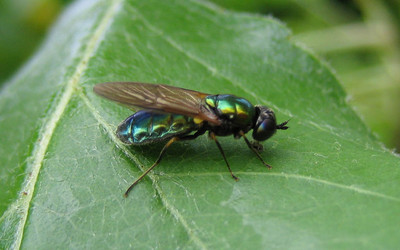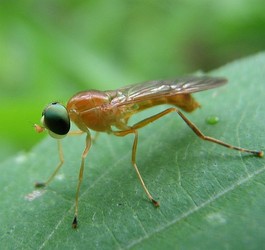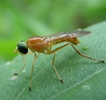Sarginae
Keith Bayless- Acrochaeta
- Amsaria sagittocera
- Cephalochrysa
- Chloromyia
- Chrysochromioides micropunctata
- Dinosargus lateritius
- Eumenogastrina angusta
- Filiptschenkia sargoides
- Formosargus
- Gongrosargus
- Himantigera
- Lobisquama barbata
- Merosargus
- Microchrysa
- Microptecticus
- Microsargus stuckenbergi
- Otochrysa bicolor
- Paraptecticus
- Ptecticus
- Ptectisargus
- Sagaricera
- Sargus
- Stackelbergia chloromyioides
Introduction
Sarginae are generally slender flies, and many members of the subfamily have metallic coloration. Sargine larvae are terrestrial scavengers, coprophages, or saprophages in decaying fruits, bulbs, or other vegetable material, leaf litter, or excrement (James 1965, James 1981).
Characteristics
All Sarginae have an aristate last antennal flagellomere and a reduced number of flagellomeres in the basal complex. Most Sarginae have five flagellomeres and crossvein m-cu, but a few species have more flagellomeres and no crossvein m-cu (Woodley 2001).
References
James, M.T. 1965. Family Stratiomyidae. Pp.299-319, in Stone, A., C. Sabrosky, W. Wirth, R. Foote, J. Coulson. A catalog of the Diptera of America north of Mexico. Agricultural Research Service, USDA, IIV, 1-1696.
James, M.T. 1981. 36. Stratiomyidae. Manual Nearct. Dipt. 1: 497-511.
Woodley, N. E. 2001. A World Catalog of the Stratiomyidae (Insecta: Diptera). Myia 11: 1-473. Backhuys Publishers, Leiden.
Title Illustrations

| Scientific Name | Chloromyia formosa |
|---|---|
| Location | Boussy-St-Antoine, Ile-de-France, France |
| Specimen Condition | Live Specimen |
| Sex | Female |
| Source | Chloromyia formosa |
| Source Collection | Flickr |
| Image Use |
 This media file is licensed under the Creative Commons Attribution-NonCommercial-ShareAlike License - Version 2.0. This media file is licensed under the Creative Commons Attribution-NonCommercial-ShareAlike License - Version 2.0.
|
| Copyright | © 2004 CÚcile Bassaglia |
| Scientific Name | Ptecticus trivittatus |
|---|---|
| Location | Lake Fayetteville, Washington County, Arkansas, USA |
| Specimen Condition | Live Specimen |
| Identified By | Martin Hauser |
| Life Cycle Stage | Adult |
| Size | ~15 mm |
| Source | Photo#113222 |
| Source Collection | BugGuide.Net |
| Image Use |
 This media file is licensed under the Creative Commons Attribution-NonCommercial-NoDerivs License - Version 1.0. This media file is licensed under the Creative Commons Attribution-NonCommercial-NoDerivs License - Version 1.0.
|
| Copyright |
© Edward Trammel

|
About This Page
Keith Bayless

North Carolina State University, Raleigh, North Carolina, USA
Correspondence regarding this page should be directed to Keith Bayless at
Page copyright © 2008 Keith Bayless
All Rights Reserved.
- First online 28 September 2008
- Content changed 28 September 2008
Citing this page:
Bayless, Keith. 2008. Sarginae. Version 28 September 2008 (under construction). http://tolweb.org/Sarginae/23962/2008.09.28 in The Tree of Life Web Project, http://tolweb.org/










 Go to quick links
Go to quick search
Go to navigation for this section of the ToL site
Go to detailed links for the ToL site
Go to quick links
Go to quick search
Go to navigation for this section of the ToL site
Go to detailed links for the ToL site